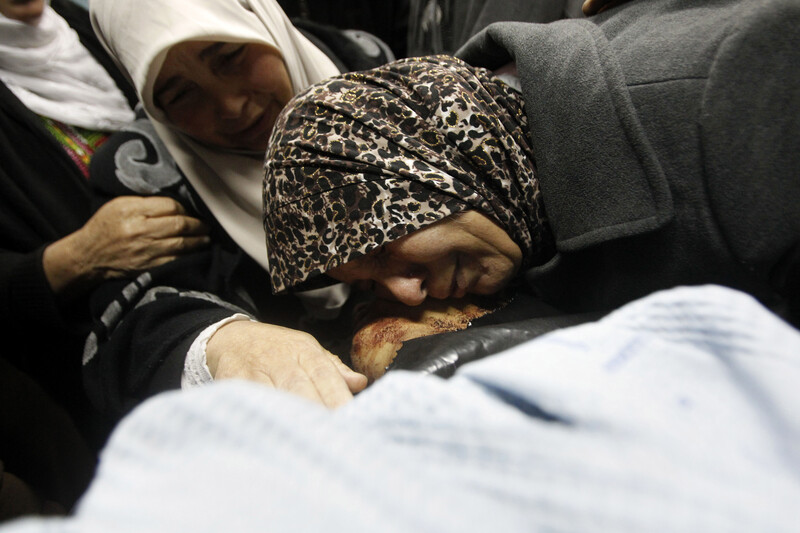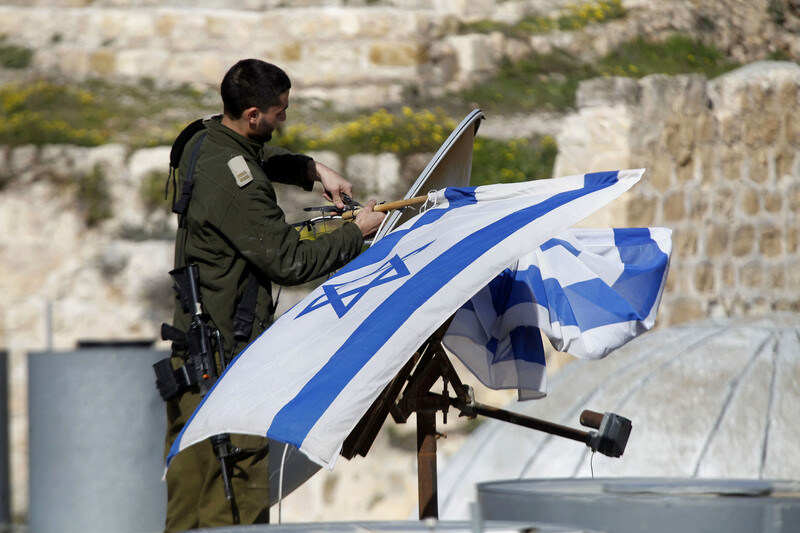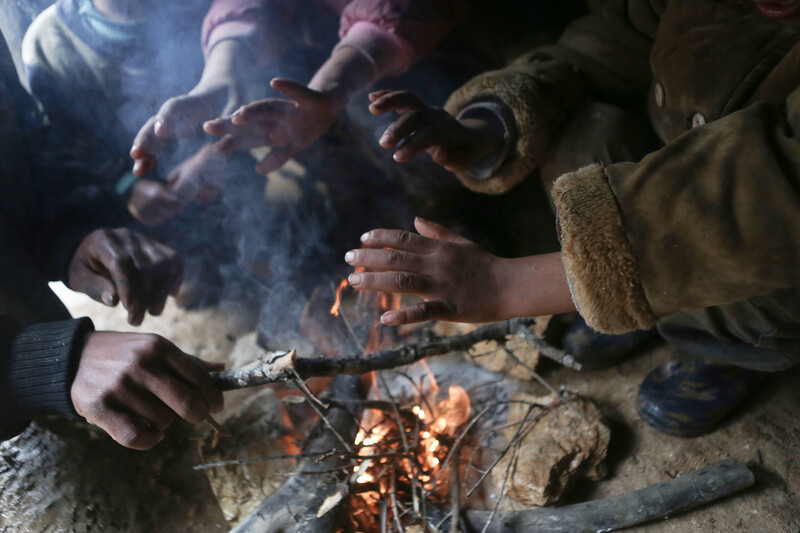The Electronic Intifada 6 February 2016

Palestinians take cover from the rain following Friday prayers at al-Aqsa mosque in Jerusalem’s Old City on 1 January.
On New Years day, a Palestinian citizen of Israel opened fire at a pub in central Tel Aviv, killing the manager and a customer, and commandeered a taxi, killing the driver. Nashat Milhem, the gunman, was tracked down a week later and killed by Israeli police near his hometown of Arara.
Nineteen more Palestinians and two additional Israelis were killed during the month of January, continuing the phase of sharply increased and deadly confrontation that began in late 2015, the deadliest year for Palestinians in the occupied West Bank in a decade.
Most Palestinians were killed at settlements and checkpoints during what Israel says were attacks.
Seven of those slain in January were youths from the West Bank village of Sair, which witnessed intense violence by Israeli forces in preceding months. All were shot dead while allegedly attempting to stab Israeli soldiers in the Hebron area.
West Bank attacks
Several Israelis were injured during attacks waged by individual Palestinians, independent of any command from armed resistance groups, including a 17-year-old in Jerusalem and a pregnant woman living in a West Bank settlement.
Three Israeli soldiers were injured when a Palestinian Authority officer allegedly opened fire on them at a West Bank checkpoint. The officer, Amjad Sukkari, a 34-year-old father of four, was shot and killed during the incident.
Three Palestinians were shot dead by Israeli settlement guards, including a 13-year-old girl, and in a separate incident, two youths who stabbed two women, one of them fatally. Israeli media reported that the two Palestinians, Ibrahim Usama Allan, 23, and Hussein Abu Ghosh, 17, were shot as they ran, suggesting the two may have been extrajudicially executed.
An investigation by an Israeli newspaper found that a Palestinian boy was shot dead on his way to physics class after soldiers at a checkpoint opened fire on the taxi in which he was traveling when another youth, who was also shot dead, jumped out of the vehicle while brandishing a weapon.
Two Palestinian men were killed by soldiers in the West Bank in what witnesses said was “an act of cold blood”: the pair were shot immediately after soldiers stopped the car in which they were traveling and asked them to get out. They were not carrying knives, witnesses told a Palestinian rights group.
Israel was still holding the bodies of 10 alleged Palestinian attackers, all from Jerusalem, at the end of the month.
Demonstrators, fighters killed
Israeli forces meanwhile killed a Palestinian during confrontations with youths in Beit Jala, near the West Bank city of Bethlehem, as well as two demonstrators in the Gaza Strip, one of them a child. Another boy in the West Bank was killed when an explosive device he was handling detonated prematurely.
A Palestinian fighter was killed when Israeli forces shelled a group carrying out what Israel claimed was an armed operation in northern Gaza near the boundary with Israel and several other fighters were killed in tunnel accidents during the month.
Rafah crossing, the sole point of exit and entry for the vast majority of the 1.8 million Palestinians in Gaza, remained closed throughout the month; Egypt has kept the crossing closed since late October 2014, except for 39 days of partial openings.
“Authorities in Gaza indicated that over 25,000 people with urgent needs, including around 3,500 medical cases, are registered and waiting to cross,” the United Nations monitoring group OCHA reported.
Meanwhile, Gaza residents endured electricity cuts of up to 20 hours per day during harsh winter conditions, up from a daily average of 12-15 hours of cuts, “due to breaks in the feeder lines from Israel and Egypt and insufficient fuel supply to operate the Gaza power plant,” according to OCHA. The group added that a man “suffocated to death after inhaling toxic smoke while heating his home using charcoal.”
And in the West Bank, dozens of Palestinians were left homeless when their houses were destroyed by Israeli forces on the pretext that they were built without permits, and UN officials called for a halt to Israel’s plans to forcibly transfer Palestinian Bedouins in the Jerusalem area.
Israeli forces demolished two homes and sealed another belonging to three families of Palestinians accused of attacks on Israelis, displacing 19 people, including seven children, according to OCHA.
No relief for Palestinians in Syria
The UN agency for Palestine refugees, UNRWA, stated that more than half of the 450,000 Palestinian refugees who remain in Syria are internally displaced and 95 percent of them are in need of sustained humanitarian aid.
“Around 42,000 Palestinian refugees from Syria have fled to Lebanon and 18,000 to Jordan where they face a marginalized and precarious existence,” UNRWA said.
In a study released in January, Amnesty International reported that inadequate funding and reduced UN support for refugees, and a freeze on visas by the Lebanese government, “has resulted in a climate in which refugee women from Syria, especially those who head their households, are at risk of violence, harassment and exploitation and are unable to seek redress from the authorities.”
“Over four million people have fled Syria since the start of the crisis in 2011 with more than 1 million fleeing to Lebanon,” Amnesty stated. “This means that about 25 percent of the country’s population are refugees from Syria and Lebanon has more refugees per capita than any other country in the world.”
“Just over half the Palestinian refugee population from Syria [in Lebanon] are women and girls,” according to Amnesty.

Israeli forces search the streets near a pub following a shooting attack carried out by a Palestinian man with Israeli citizenship who escaped the scene, Tel Aviv, 1 January. Two Israelis were shot dead in the attack and the gunman killed the driver of a taxi he commandeered to make his getaway. He was found by police and killed a week later.
ActiveStills
Mourners carry the bodies of several Palestinians who were slain while allegedly carrying out attacks against Israelis during a funeral in the West Bank city of Hebron on 2 January after their bodies were handed over by Israel, which had withheld the remains for weeks.
APA images
Mourners carry the bodies of Anas Hammad and Muhammad Ayyad, who were shot and killed during separate alleged car ramming attacks on Israeli soldiers the previous month, during their funeral in the occupied West Bank village of Silwad, northeast of Ramallah, on 3 January.
APA images
The mother of 18-year-old Ahmad Younis Kawazba mourns over her son’s body at a hospital in the West Bank city of Hebron on 4 January. Kawazba was shot dead after he allegedly attempted to stab an Israeli soldier at the Gush Etzion settlement junction on the main road between Jerusalem and Hebron in the West Bank.
APA images
An Orthodox Christian boy takes part in Christmas mass at the Church of Saint Porphyrius in Gaza City on 7 January.

Palestinian men remove debris in the destroyed home of Bahaa Alayan, a Palestinian who allegedly killed three Israelis in Jerusalem in October, after Israeli forces used jackhammers to tear down the walls of the middle floor of a three-story building in the East Jerusalem neighborhood of Jabal al-Mukabir on 4 January. Alayan was shot dead during the incident.
APA images
Tair Kaminer, a 19-year-old Israeli from Tel Aviv, walks into the Tel HaShomer military base where she announced her refusal to comply with conscription in the Israeli army on 10 January. The young woman said she refuses to take part in the occupation after she spent a year volunteering with youth in southern Israel, near the boundary with Gaza.
ActiveStills
Palestinians call on Egypt to open Rafah crossing during a demonstration in front of the country’s representative offices in Gaza City on 14 January. The woman’s sign reads: “Until when will the siege last?”
APA images
Israeli forces gather around the body of Haitham Mahmoud Yassin, who was shot dead during an alleged stabbing attack in the village of Assira al-Shamaliya near Nablus, in the northern West Bank, on 14 January.
APA images
Activists hold sections of a wall mocking the one Israel is building in the West Bank during a protest against the occupation on the main Jerusalem-Hebron highway in full view of Israeli settlers, Beit Jala, West Bank, 15 January.
ActiveStills
Mourners carry the body of Muayyad Jabarin during his funeral in the West Bank village of Sair, east of the West Bank city of Hebron, on 15 January. The 20-year-old man was shot dead the previous after he allegedly attempted to stab Israeli soldiers at the Beit Einoun junction near Hebron.
APA images
Palestinians gather at a Qatari-funded housing complex in Khan Younis, southern Gaza Strip, on 16 January. More than 1,000 Palestinian families have taken possession of new apartments in the first phase of the large housing project that sits on dunes that were part of the former Israeli settlement of Gush Katif. Hanging on the building are huge banners showing the former Qatari ruler, Sheikh Hamad bin Khalifa al-Thani, right, his son, the current emir, Tamim bin Hamad bin Khalifa al-Thani, and the Qatari flag.
APA images
An Israeli Border Police officer stands guard during the demolition of a Palestinian house under the order of the Israeli army in the West Bank town of Dura, south of Hebron, on 20 January. The home was demolished on the pretext that its owners lacked an Israeli-issued construction permit.
APA images
Nasser Nawaja, a Palestinian activist and human rights worker from the West Bank village of Susiya, is escorted by Israeli police to his hearing at a Jerusalem court on 20 January. Nasser was arrested following the arrests of two left-wing Israeli activists after an Israeli TV station aired video made by right-wing activists trying to attack human rights groups.
ActiveStills
Israeli soldiers stand guard during the demolition of a Palestinian home in the West Bank village of Beit Ula, west of Hebron, on 21 January. The owners of the house said they were informed by the army that the demolition was carried out because they did not have an Israeli-issued construction permit.
APA images
An Israeli soldier removes an Israeli flag from a house as dozens of settlers were evacuated from two homes in the heart of the West Bank city of Hebron on 22 January, a day after they forced their way into the buildings.
APA images
Palestinians in the Dheisheh refugee camp near the West Bank city of Bethlehem celebrate the 14th birthday of Ahmad Manara, a boy who allegedly carried out a stabbing attack in a Jerusalem settlement along with his 15-year-old cousin, who was shot dead during the incident. Ahmad was shot and gravely injured during the incident and remains in Israeli detention.
ActiveStills
Palestinian Bedouin children warm themselves next to a fire in their family’s tent on a rainy day in the village of Ein Qiniya near the West Bank city of Ramallah on 25 January.
APA images
Palestinian civil defense workers use a kayak to evacuate people from a flooded area following heavy rainfall in Rafah, southern Gaza Strip, on 27 January.
APA images
Fayha Shalash, the wife of hunger-striking journalist Muhammad al-Qiq, holds their daughter in front of a protest tent in the West Bank village of Dura on 27 January. Al-Qiq’s health deteriorated after weeks of hunger strike in protest of his detention without charge or trial after Israeli forces arrested him at his home in November.
APA images
Palestinian children stand on the rubble of their house demolished by Israel on the pretext that it was built without a construction permit in the East Jerusalem neighborhood of Shuafat on 27 January.
APA images
Fighters with the Qassam Brigades, the armed wing of Hamas, keep vigil next to the bodies of seven comrades who died after the collapse of a tunnel used for military purposes during winter rains a day earlier, Gaza City, 29 January.
APA images
A roof collapses under the weight of onlookers during the Gaza City funeral of seven Hamas fighters who were killed a day earlier when a tunnel near Gaza’s boundary with Israel collapsed during winter rains, 29 January.
APA images
Israeli troops gather around the body of Amjad Sukkari, a Palestinian Authority officer who was shot dead after allegedly opening fire on a group of soldiers at a checkpoint near the West Bank city of Ramallah on 31 January.
APA images
Palestinians gather in Gaza City on 31 January to pay tribute to seven fighters with the Qassam Brigades, the military wing of Hamas, who died after a tunnel collapsed during winter rains days earlier.
APA images

